|
|
|
Sort Order |
|
|
|
Items / Page
|
|
|
|
|
|
|
| Srl | Item |
| 1 |
ID:
123399
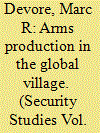

|
|
|
|
|
| Publication |
2013.
|
| Summary/Abstract |
Few issues are more important to international relations scholars than understanding how globalization is shaping the production of armaments. Within this context, this article examines both whether and how small and medium states can maintain defense-industrial bases capable of contributing to their national security. To preview the conclusion, although defense-industrial self-sufficiency has become an illusion for most states, even small and medium states can develop defense-industrial capabilities that enhance both their ability to autonomously employ their armed forces and secure access to foreign armaments. Moreover, governments possess a range of options for achieving these objectives, including a fundamental choice between accepting foreign direct investment and pursuing unrestrained arms exports. Governments unwilling to sanction foreign ownership of their defense industries can have recourse to unrestricted exports; alternatively, states uncomfortable with liberal exports can encourage foreign direct investment. With this in mind, a lasting diversity is likely to persist in even similarly endowed states' defense industries and defense-industrial policies.
|
|
|
|
|
|
|
|
|
|
|
|
|
|
|
|
| 2 |
ID:
123395
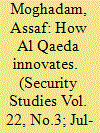

|
|
|
|
|
| Publication |
2013.
|
| Summary/Abstract |
Innovative terrorist organizations pose exceptionally dangerous threats because of their potential to surprise declared enemies, inflict heavy costs upon them, and set new trends that other militant groups seek to emulate. Despite this importance, researchers have shed little light on where terrorist innovation originates. Although military innovation scholars have emphasized the importance of both top-down and bottom-up innovation, the few existing studies on terrorist innovation have acknowledged the importance of the terrorist leadership but largely ignored the role played by middle- or lower-ranking operatives in the innovation process. This study examines the planning of the September 11, 2001 attacks and finds that, contrary to the predominant claims on terrorist innovation, the 9/11 attacks featured both top-down and bottom-up processes of innovation, with the latter including a critical role played by an independent terrorist entrepreneur. Theoretically, the findings suggest that the conventional wisdom of the predominance of top-down innovation in terrorism is dependent on a problematic assumption, namely that terrorist groups are centralized, hierarchical, and localized entities. As more terrorist groups adopt decentralized structures, they are increasingly likely to display multi-directional processes of innovation. The study has important implications for counterterrorism policy. It suggests that thwarting the most innovative terrorist groups requires targeting senior- and middle-management operatives of the group itself and expending greater effort at apprehending independent terrorist innovators with fluid organizational affiliations. A mix of offensive and defensive counterterrorism strategies, coupled with greater international cooperation, is critical to achieving this goal.
|
|
|
|
|
|
|
|
|
|
|
|
|
|
|
|
| 3 |
ID:
123394
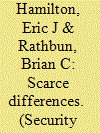

|
|
|
|
|
| Publication |
2013.
|
| Summary/Abstract |
A divide has opened up between offensive and defensive realism as to the relative scarcity of security in the international system, with powerful implications for the vision each approach offers about the nature of international politics. Yet we still do not understand why the two diverge given their common neorealist foundations. This article reviews implicit, explicit, and other potential explanations of that difference-the relationship between power and security, the offense-defense balance, the prevalence and efficiency of balancing vs. bandwagoning, and the role played by uncertainty in decision-making-and finds them lacking in their ability to provide an adequate account that is systemic and structural in nature, does not violate arguments the scholars have made in practice, and does not confuse cause with effect. Finding prior efforts lacking, this article proposes that the distinction could be logically rooted in material scarcity, a familiar theme in realism historically that has been ignored in more recent formulations. Drawing a distinction between a "dangerous world" in which uncertainty is the core problem and a "competitive world" in which scarcity bedevils state relations helps explain where offensive and defensive realism both diverge and converge.
|
|
|
|
|
|
|
|
|
|
|
|
|
|
|
|
| 4 |
ID:
123391
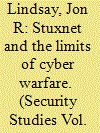

|
|
|
|
|
| Publication |
2013.
|
| Summary/Abstract |
Stuxnet, the computer worm which disrupted Iranian nuclear enrichment in 2010, is the first instance of a computer network attack known to cause physical damage across international boundaries. Some have described Stuxnet as the harbinger of a new form of warfare that threatens even the strongest military powers. The influential but largely untested Cyber Revolution thesis holds that the internet gives militarily weaker actors asymmetric advantages, that offense is becoming easier while defense is growing harder, and that the attacker's anonymity undermines deterrence. However, the empirical facts of Stuxnet support an opposite interpretation; cyber capabilities can marginally enhance the power of stronger over weaker actors, the complexity of weaponization makes cyber offense less easy and defense more feasible than generally appreciated, and cyber options are most attractive when deterrence is intact. Stuxnet suggests that considerable social and technical uncertainties associated with cyber operations may significantly blunt their revolutionary potential.
|
|
|
|
|
|
|
|
|
|
|
|
|
|
|
|
| 5 |
ID:
123397
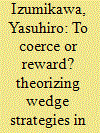

|
|
|
|
|
| Publication |
2013.
|
| Summary/Abstract |
Wedge strategy, a policy of preventing or dividing an adversary coalition, has been attracting increasing scholarly attention. In particular, Timothy Crawford has articulated the concept and claims that reward-based strategies are more effective than coercive strategies that actually strengthen the ties between enemies. Although this sounds logical, history provides sufficient cases that contradict the claim. Why? To answer the question, I develop a theory of wedge strategy by utilizing the concept of reward power. I then argue that although countries seeking to divide adversary coalitions usually prefer reward-based strategies, they turn to coercive measures when a divider state perceives grave threats as a result of a target state's strong alignment with its primary enemy but does not have sufficient reward power to split the adversaries. I examine this theory through two case studies of us wedge strategies toward the Sino-Soviet alliance during the early Cold War period. This article addresses the specific puzzle of choices between reward and coercive wedge strategies and offers broader theoretical implications regarding the utility of the concept of reward power in international and alliance politics.
|
|
|
|
|
|
|
|
|
|
|
|
|
|
|
|
| 6 |
ID:
123392


|
|
|
|
|
| Publication |
2013.
|
| Summary/Abstract |
Private diplomacy and secret agreements among adversaries are major features of international relations. Sometimes secret reassurance has resulted in cooperation and even peace between longtime adversaries. Yet rationalist theories consider private diplomatic communication as cheap talk. How do we explain this gap between theoretical expectations and the empirical record? I offer a theory that explains how, why, and when a leader may convince an enemy that his private reassurances are credible even when they are not costly to undertake. I also account for the conditions under which recipients of such reassurance infer the leader's benign intentions from these secret interactions. I claim that leaders engage in secret reassurance with the enemy when they face significant domestic opposition. The adversary can leverage the initiator's domestic vulnerability by revealing the secret reassurance, thereby imposing domestic punishment on the initiator. Further, by entering into private or secret negotiations and offering their adversary such leverage, initiators generate "autonomous risk" that exists beyond their control. I evaluate this theory against two empirical cases. The first case looks at Richard Nixon's secret assurances to the Chinese leadership in 1972. The second examines the secret negotiations between Israeli officials and the leadership of the Palestine Liberation Organization that ended with the signing of the Oslo I Accord in 1993.
|
|
|
|
|
|
|
|
|
|
|
|
|
|
|
|
|
|
|
|
|